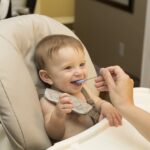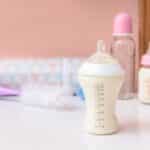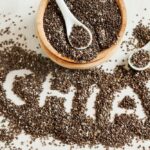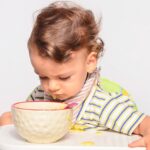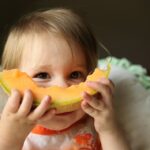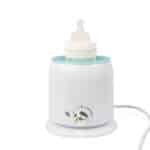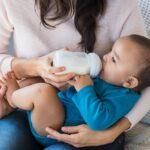Being a parent is a busy time, you are surviving on a lack of sleep, overwhelmed by the million things on your to-do list!
Losing the scoop from your formula happens more often than you think and when you are making up bottles every day it can be really frustrating.
I know as an exhausted parent there were many occasions where I would go to make a bottle and the scoop has decided to go on vacation!
So what do you do if this happens to you and you need to know how much a scoop of formula actually is? No need to panic we have gathered together a whole host of information to get you the answers that you need.
Firstly, did you know that every brand of formula will use a slightly different measurement per scoop, but for the most part, a scoop of the formula is around 3.5 teaspoons.
It can also be measured as a single rounded tablespoon or if you have a weighing scale it is around 3 grams of formula per scoop.
Formula Weights Per Scoop By Brand
Similac
| Formula Type | Grams Per Scoop | Ounces Per Scoop | Tablespoons Per Scoop | Tablespoons Per 6 oz Bottle | |
| Advance | 8.7 | 0.306883 | 0.5800 | 3.48 | |
| NeoSure | 9.6 | 0.33863 | 0.6400 | 3.84 | |
| Sensitive | 8.3 | 0.292774 | 0.5533 | 3.3198 |
Enfamil
| Formula Type | Grams Per Scoop | Ounces Per Scoop | Tablespoons Per Scoop | Tablespoons Per 6 oz Bottle |
| Infant | 8.8 | 0.310411 | 0.5866 | 3.5196 |
| Gentlease | 8.7 | 0.306883 | 0.5800 | 3.48 |
| Sensitive | 8.9 | 0.313938 | 0.5933 | 3.5598 |
| Enspire | 8.8 | 0.310411 | 0.5866 | 3.5196 |
| Reguline | 8.7 | 0.306883 | 0.5800 | 3.48 |
| A.R. | 9 | 0.317466 | 0.6000 | 3.6 |
| EnfaCare | 9.8 | 0.345685 | 0.6533 | 3.9198 |
Parent’s Choice
| Formula Type | Grams Per Scoop | Ounces Per Scoop | Tablespoons Per Scoop | Tablespoons Per 6 oz Bottle |
| Infant | 8.8 | 0.310411 | 0.5866 | 3.5196 |
| Gentle | 8.9 | 0.313938 | 0.5933 | 3.5598 |
| Sensitivity | 9 | 0.317466 | 0.6000 | 3.6 |
| Advantage | 8.8 | 0.310411 | 0.5866 | 3.5196 |
| Soy | 8.9 | 0.313938 | 0.5933 | 3.5598 |
| Complete Comfort | 9 | 0.317466 | 0.6000 | 3.6 |
Gerber Good Start
| Formula Type | Grams Per Scoop | Ounces Per Scoop | Tablespoons Per Scoop | Tablespoons Per 6 |
| Gentle | 8.7 | 0.306883 | 00.5800 | 3.48 |
| Soothe | 8.7 | 0.306883 | 0.5800 | 3.48 |
| Comforting Probiotics | 8.7 | 0.306883 | 0.5800 | 3.48 |
| Soy | 8.9 | 0.313938 | 0.5933 | 3.5598 |
Earth’s Best
| Formula Type | Grams Per Scoop | Ounces Per Scoop | Tablespoons Per Scoop | Tablespoons Per 6 |
| Dairy | 8.7 | 0.306883 | 0.5800 | 3.48 |
| Gentle | 8.7 | 0.306883 | 0.5800 | 3.48 |
| Organic Sensitivity | 8.7 | 0.306883 | 0.5800 | 3.48 |
| Non-DHA | 8.9 | 0.313938 | 0.5933 | 3.5598 |
Happy Baby Organics
| Formula Type | Grams Per Scoop | Ounces Per Scoop | Tablespoons Per Scoop | Tablespoons Per 6 |
| Stage 1 | 8.9 | 0.313938 | 0.5933 | 3.5598 |
| Sensitive | 9 | 0.317466 | 0.6000 | 3.6 |
| Stage 2 | 9 | 0.317466 | 0.6000 | 3.6 |
Up & Up
| Formula Type | Grams Per Scoop | Ounces Per Scoop | Tablespoons Per Scoop | Tablespoons Per 6 |
| Advantage | 8.8 | 0.310411 | 0.5866 | 3.5196 |
| Gentle | 8.9 | 0.313938 | 0.6000 | 3.6 |
| Sensitivity | 8.8 | 0.310411 | 0.5866 | 3.5196 |
| Infant Non-GMO | 9 | 0.317466 | 0.6000 | 3.6 |
Kirkland Signature
| Formula Type | Grams Per Scoop | Ounces Per Scoop | Tablespoons Per Scoop | Tablespoons Per 6 |
| ProCare | 8.8 | 0.310411 | 0.5866 | 3.5196 |
Measuring Baby Formula Without A Scoop
As a general rule, you will find that most brands use around 3.5 teaspoons or roughly 3 grams of formula per serving – this is to make up a 2-ounce bottle.
If you don’t have a scoop the most reliable way to measure your formula is to use a weighing scale.
We have included a few of the measurements for some of the popular brands in the tables above but if the one you are using is not there, you may be able to find all the information either on the can itself or on the manufacturer’s website.
View in gallery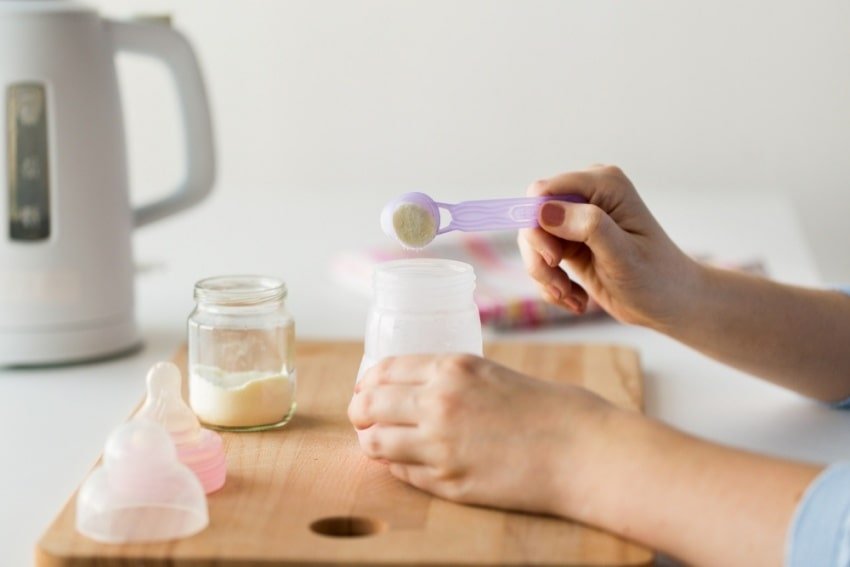
Using A Measuring Spoon
Once your scoop has gone missing in desperation you may begin to go through your kitchen draws to find something a similar size – a measuring spoon.
That measuring spoon may look like it is a similar size to your lost scoop, the reality is that it isn’t and if you do use it you will end up with bottles of varying portions. This is not going to be great for your baby.
Using A Kitchen Scale
If you have lost your scoop the most accurate way to measure out your formula is to use a kitchen scale like the one below.
[amalinkspro type=”showcase” asin=”B07S6F6LHQ” apilink=”https://www.amazon.com/dp/B07S6F6LHQ?tag=mominformedcom-20&linkCode=osi&th=1&psc=1″ new-window=”true” addtocart=”false” nofollow=”true” sc-id=”4″ imgs=”LargeImage” link-imgs=”false” specs=”【PRECISE WEIGHT】 The digital food scale with built-in four high-precision load sensors, quick and accurate 0.1oz/1g increments when adding ingredients, measuring range: 0.1oz to 22 lbs (2g/3g to 10kg).~~~【MULTIFUNCTION SCALE】 9×6.3 platform and Large lcd display for easy readout in g, kg, lb: oz, fl.oz and ml. This digital weight scale is for better cooking, baking, tracking intake, weight loss and postage.” btn-color=”#ff9900″ btn-text=”Buy on Amazon” alignment=”aligncenter” hide-prime=”0″ hide-image=”0″ hide-price=”0″ hide-button=”0″ width=”750″]Nicewell Food Scale[/amalinkspro]
Most households have a kitchen scale to hand and the formula manufacturers have provided the correct portion size for your baby down to a tenth of a gram.
Using other methods will be fine for a one-off measure but should not be used long term as the variations in measurements can have serious repercussions, even more so if you are under portioning the formula.
Results Of Using The Wrong Amount Of Formula
Every can of formula, no matter the brand or type will come with its own scoop. This scoop will provide the correct portion size of the formula for your baby consistently.
This is vitally important as each portion contains the correct balance of vitamins, minerals, and nutrients to feed your baby and keep them hydrated when mixed with the correct portion of water.
Using more or less formula than is required will not have detrimental effects on your baby’s health if it happens once or twice.
But if this is portioning happens over an extended period of time it can lead to nutritional deficiencies and even developmental problems. In extreme cases, it could lead to stroke, seizure, or death.
All Formula Scoops Are The Same Size, Right?
Unfortunately, the answer is no they are not all the same size and so they are not interchangeable, even within the same brand.
If you look at a selection of scoops they may appear to be exactly the same size but can vary by as little as a tenth of a gram.
I know this may not seem like much at all and I hear you saying ‘surely such a small amount is not going to cause any harm?’, but think about how many scoops of formula you measure out and feed to your baby in a 24 hour period.
The average 2 months old will consume 5-6 bottles a day and will take 4-5 ounces per feeding, so we can estimate that they will be drinking around 30 ounces of formula a day so you would be measuring out fifteen scoops.
So even if your measurements are only over by one-tenth of a gram purely by using a different scoop, by the end of that 24 hour period your baby would have consumed an extra 1.5 grams of formula.
Now as a one-off that is not going to be a huge problem but if that is happening consistently your baby will consuming 17% more than their recommended daily allowance of minerals, nutrients, and vitamins.
It is similar to your eating an extra 340 calories, as a one-off treat there is no real problem but if you consistently do this every single day then you will quickly see the results in your waistline.
The same problem occurs if you use a scoop that is smaller than your formula scoop, such as the 1/2 teaspoon measuring spoon and you use this for 24 hours.
By the end of that day, your baby would have consumed more than 12% less nutrition than is recommended.
View in gallery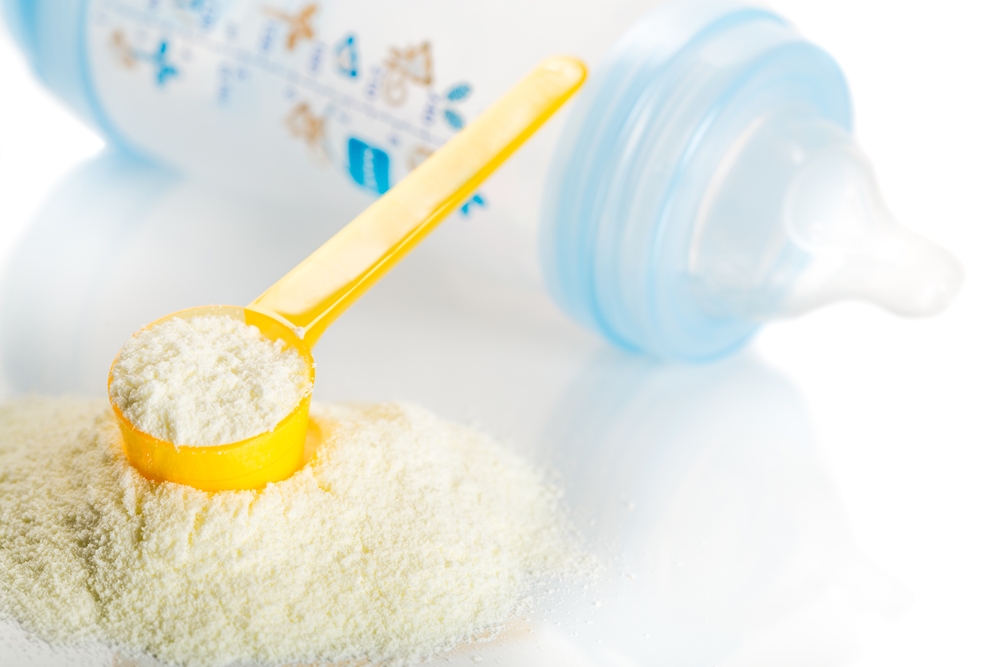
How Many Ounces Are There In The Average Scoop Of Formula?
To begin with, there is not an average scoop of formula and because the scoops are so small it is extremely difficult to measure in ounces.
All of the scoops that we looked at, their scoop size ranged from 8.7 grams to 9.8 grams, both of these work out roughly to be one-third of an ounce.
Because the differences in the scoop sizes are so tiny your kitchen scale may not be able to show the weight of the formula in ounces.
It would be best to avoid measuring formula in ounces rather than grams or scoops as it is difficult to find a kitchen scale that is precise or accurate enough to be consistent.
How Many Grams Are There In The Average Scoop Of Formula?
This measurement is easier to find as most manufacturers include the formula portion size in grams on both their packaging and website.
If you do have a very precise kitchen scale that measures to the tenth of a gram, you could use it to substitute for the normal scoop provided in your can of formula.
Again there is a wide range of different-sized scoop sizes but for the most part, are 8.7 – 8.8 grams. This does not include any formula that is designed to address a specific concern or is dairy-free.
FAQs
What is a scoop of baby formula?
A scoop of baby formula is very close to a tablespoon. So even if you are unfortunate enough to lose that scoop, you should have a few tablespoons hanging around to measure out your formula.
Can I use half a scoop of formula?
You should only be using full level scoops of baby formula and these should be mixed with the correct amount of water. It is not recommended that you use half a scoop of formula.
What happens if you don’t put enough formula in a bottle?
A small amount of extra formula is not going to be a huge problem… it is after all just a bit of added nutrition.
But if there is so much dry formula in the mixture that your baby isn’t getting enough water, then they could suffer from constipation and dehydration.
Another problem is that if the formula is too thick then your baby is going to struggle to drink it from their bottle, meaning that you are going to end up with a hungry, cranky little one.
The Final Thought
The truth is that losing the scoop from your baby formula happens to the best of us and there are alternatives that can be used as a short-term solution. But these alternatives are never going to be as accurate as using the scoop itself.
If you do have to use an alternative for an extended period of time then you will really require a kitchen scale that is precise to one-tenth of a gram.
This will ensure that your baby gets the correct amount of formula and so the right amount of nutrition, vitamins, and minerals that are recommended.
